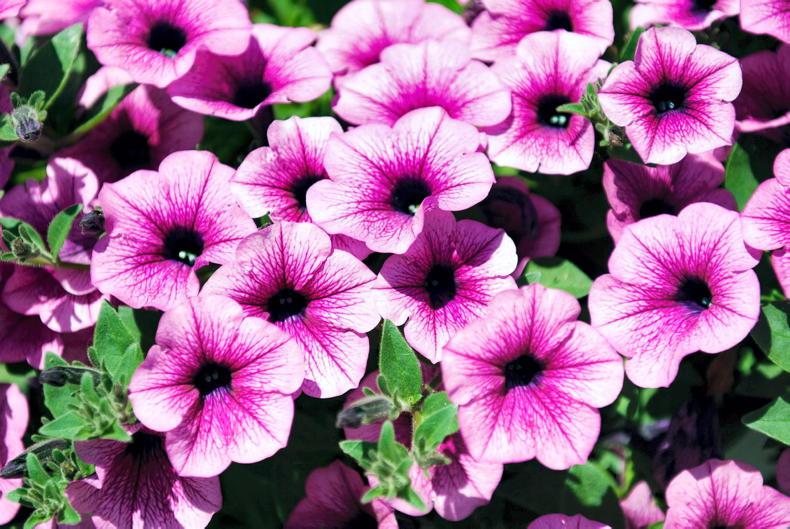Name: Crinum lily.
Botanical name: Crinum x powellii.
Family: Although it is called a lily and looks like a lily flower, the crinum lily is actually a member of the Amaryllis family, the Amaryllidaceae and the connection with other family members, such as amaryllis and hippeastrum is obvious as first glance.
The beautiful crinum lily is in flower these days. This is just the start of its long flowering season that runs from early August to late September. No matter how many times over the years that you see this plant coming into flower, its appeal simply grows.
The sheer size of the flower and its pristine waxy beauty are always impressive. The arching trumpets look exotic and it is native to South Africa, where it is called, in English, the river lily or the veld lily, or swamp lily. None of these names are much used in this country, where it is simply known as crinum or crinum lily.
As flower bulbs go, this is outsized in all its parts. The flowers are large, each trumpet fully 10cm across, and often they are carried in a group of as many as 20 flowers, opening in succession and flowering over a period of weeks. The trumpets are sweetly fragrant, pure white or very delicate light purple-pink. Either colour is very pretty. The pink contrasts with autumn colour, while the pure white is outstandingly fresh and new at this time of year.
The flowers are carried at the top of sturdy stems that are often well over one metre tall, rounded and thick as a man’s thumb. The flower stems emerge from the rosette of wide strappy leaves in a matter of a few days. They have so much vigour because they arise from a very large bulb, as big as the largest onion. This flower is always best as a clump of blooms, and this happens eventually, the bulbs splitting naturally each year.
Long-established clumps are sometimes seen in old gardens and it would appear to be a resilient plant that lasts many decades.
Like many South African native plants, crinum is not completely hardy, though it survived the bad winters of 2009/2010.
It would not be a big task to cover the tall necks of these large bulbs during a very frosty spell. The bulbs push up as much as halfway out of the ground, the neck thickly clad with many layers of papery skins.
For such a beautiful flower, its bulbs are rarely seen for sale in garden centres, because it is slow to increase in numbers. If you get a bulb or two, choose a place to plant where the splendid flowers will be seen to be enjoyed for many years to come, near a doorway or garden gate, or close to a sunny wall where it seems to flower more prolifically.
Petunias are very long-lasting, being short-lived perennials, although treated as annuals.
They flower very late if well looked after. That means keeping them well watered late into the summer and early autumn and feeding them every couple of weeks to keep them growing. It is surprising how well they can last in autumn if there is no early season frost.

The other aspect of being perennial is that they can be raised from cuttings. Plants raised from cuttings taken now can be over-wintered indoors on a window sill and planted out next May. Small plants are not difficult to keep and they can be pinched back to make really tight bushy plants for planting out.
Just take a little cutting of a non-flowering sideshoot, before it gets big enough to carry a flower. It roots well at this stage, using rooting powder, and a sandy compost.
Fruit, vegetables and herbs
Raspberry canes that have finished fruiting could be pruned out and the new canes tied into position. If there are too many canes, reduce the number to about 10 or 15 per metre of row. Summer pruning of vigorous apple trees could still be carried out.
Lawn
Lawns in some areas suffered badly due to dry weather. If you have a wildflower lawn, do not use fertiliser except some phosphorus and potash if the growth is very poor. Prepare for a new lawn or reseeding by cultivating in good conditions.
Trees, shrubs and roses
Early flowering shrub roses and ramblers could now be pruned by removing some of the shoots that flowered. Trees planted over the last 12 months should be checked for moisture stress and watered if necessary, giving each young tree 10 litres or more.
Flowers
It is possible to collect seeds of perennial flowers, if it is desired to raise some new plants. Take cuttings of tender plants such as geraniums, fuchsias and African daisy to carry over winter as soon as possible. Continue feeding baskets and pots.
Greenhouse and house plants
Continue to train and side-shoot tomatoes and cucumbers. Take the tops off tomatoes to boost the green fruit that is already present. Tidy up all kinds of plant debris and, while continuing to water, be careful not to overwater, or to splash water about.






 This is a subscriber-only article
This is a subscriber-only article










SHARING OPTIONS: